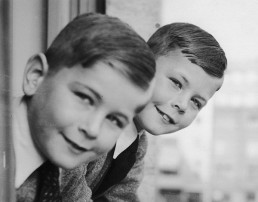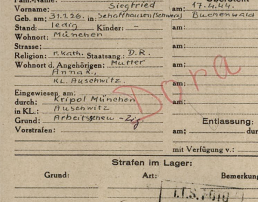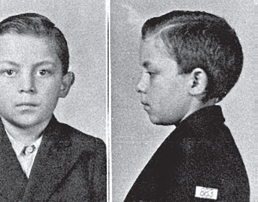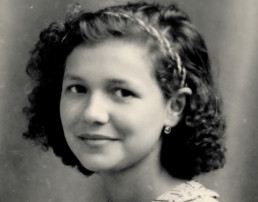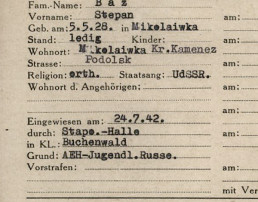Kurt Ansin
A Sinto from Magdeburg
Kurt Ansin was born on 2 October 1921. He grew up in Magdeburg. Beginning in the mid-1930s, the Sinti living there were banned from all public places and placed under constant police surveillance. The Ansin family was forced to move to the Holzweg “Gypsy camp” in 1938.
In the course of the Aktion Arbeitsscheu Reich (Operation Work-Shy Reich), Kurt Ansin and his father were arrested in June 1938 and sent to the Buchenwald Concentration Camp, where his father died. Kurt Ansin was released in 1939 and returned to Magdeburg. In 1943, however, he was arrested again and deported with his family to the “Gypsy family camp” at Auschwitz-Birkenau. From there, the SS transferred him via Buchenwald to the Ellrich-Juliushütte subcamp of the Mittelbau-Dora Concentration Camp in 1944.
Kurt Ansin survived, but almost all of his relatives were murdered. He married and had eight children. In 1984, at the age of only 61, he died of the physical and psychological conditions that were direct consequences of his time in the camp.
Kurt Ansin, February 1940.
Employees of the Rassenhygienische Forschungsstelle (Racial Hygiene Research Unit) under the direction of Robert Ritter and Eva Justin took this photo of Kurt Ansin in the Magdeburg forced labor camp. Shortly before, the Magdeburg police had registered all Sinti as alleged criminals and created a “Gypsy file.”
(Buchenwald Memorial)
Kurt Ansin (right) at the age of 15 with a friend, 1937.
Until 1938, Kurt Ansin lived with his family in Dessau-Roßlau. He was one of the few of the Sinti minority there who survived. His friend next to him, who was the same age, was murdered in Auschwitz, as were his siblings.
(Hanns Weltzel/ University of Liverpool Library)
The Gypsy Camp at Großer Silberberg in Magdeburg.
In May 1935, the city of Magdeburg established the Gypsy Camp Magdeburg Holzweg, to which Kurt Ansin, along with the other Sinti from Anhalt, was sent shortly before his arrest in 1938. In the camp, the Sinti lived under miserable conditions and constant police surveillance.
(Stadtarchiv Magdeburg)
From Auschwitz back to Buchenwald. Kurt Ansin’s prisoner registration file, 17 April 1944.
In April 1944, the SS once again sent Kurt Ansin from Auschwitz to Buchenwald and shortly thereafter to the Ellrich-Juliushütte and Harzungen subcamps. There, he was assigned to the brutal construction forced labor detail.
(Arolsen Archives)
Aktion Arbeitsscheu Reich 1938
In 1938, the number of prisoners in the concentration camps doubled. As part of the Aktion Arbeitsscheu Reich (Operation Work-Shy Reich, two waves of arrests of purported “anti-social…
"My grandfather was the only survivor of eleven siblings. Only his mom and he were left. You have to imagine that: They really wanted to wipe us out. My grandfather was later a broken and ruined man. But we are a very proud people. So, my grandfather's goal was to rebuild a big clan - that we might become many again."
Report by Janko Lauenberger about his grandfather Kurt Ansin, August 2012.
Kurt Ansin, his mother Anna Donna Ansin, and Adelheid Krause were the only three survivors of the Magdeburg Gypsy Camp. Despite this, he was initially not recognized in the GDR as a victim of the Nazi regime. His grandson recalls the family history.
(TAZ)










